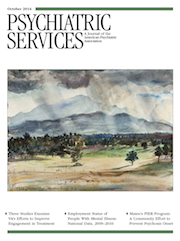Antidepressant Prescribing in Elderly Populations
To the Editor: We read with great interest the report by Simon and colleagues (1) in the July issue about the prescribing of antidepressant medications in the absence of an evidence-based indication. The study involved a large cohort of patients from geographically diverse health systems. We agree that examination of all inpatient and outpatient diagnoses over a full year likely provides a more accurate estimate of the true rate of prescribing in the absence of a diagnosis than do studies that evaluate single-encounter data, such as the National Ambulatory Medical Care Survey. The data presented by Simon and colleagues echo some of our work, which has found high rates of antidepressant prescribing to patients with no significant symptoms or a recorded psychiatric diagnosis in older adult populations, even when medical indications for use of such drugs are considered (2,3).
We have some minor concerns about the methods used by Simon and colleagues, such as the inclusion of adjustment disorder with depressed mood as a diagnosis and use of psychiatric diagnoses from the inpatient setting. Patients who are diagnosed as having major depressive disorder as medical inpatients may be more appropriately considered to have an adjustment disorder or demoralization, conditions for which there is minimal evidence to suggest benefit from pharmacotherapy. It would have been informative to know the setting from which the diagnoses were derived and how this varied by age group. Moreover, although it is true that medications such as trazodone, bupropion, and tricyclic antidepressants are often used to treat non–mental health indications, we feel that wholesale exclusion of these medications in the age analyses was unfortunate because of the potential for harm regardless of indication.
Nevertheless, applying Simon and colleagues’ most conservative 27% rate to the 10% rate of antidepressant prescription in the U.S. population of nearly 250 million adults indicates that close to seven million adults are prescribed an antidepressant in the absence of an evidence-based indication. The continued growth in antidepressant use coupled with the growth in the geriatric population means that older adults will likely account for an ever larger share of this group and be prescribed a medication with no clear indication but with the potential for negative sequelae. We believe that this is a population health matter of great importance that remains high on our list of concerns regarding treatment quality.
1 : National prevalence of receipt of antidepressant prescriptions by persons without a psychiatric diagnosis. Psychiatric Services 65:944–946, 2014Link, Google Scholar
2 : Increased risk among older veterans of prescribing psychotropic medication in the absence of psychiatric diagnoses. American Journal of Geriatric Psychiatry 22:531–539, 2014Crossref, Medline, Google Scholar
3 : Telephone-based behavioral health assessment for older adults starting a new psychiatric medication. American Journal of Geriatric Psychiatry 19:851–858, 2011Crossref, Medline, Google Scholar



